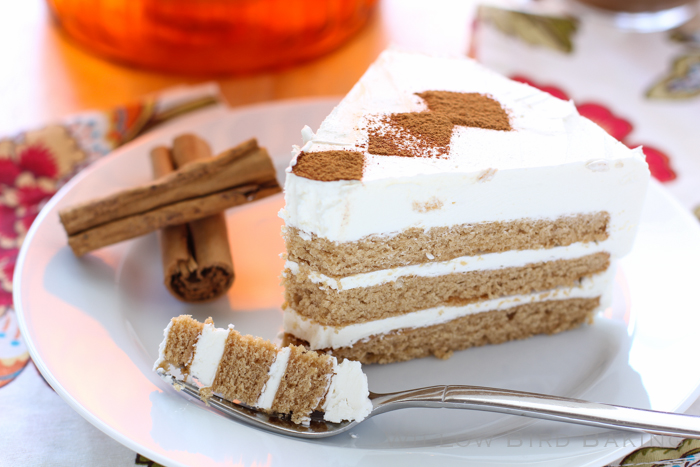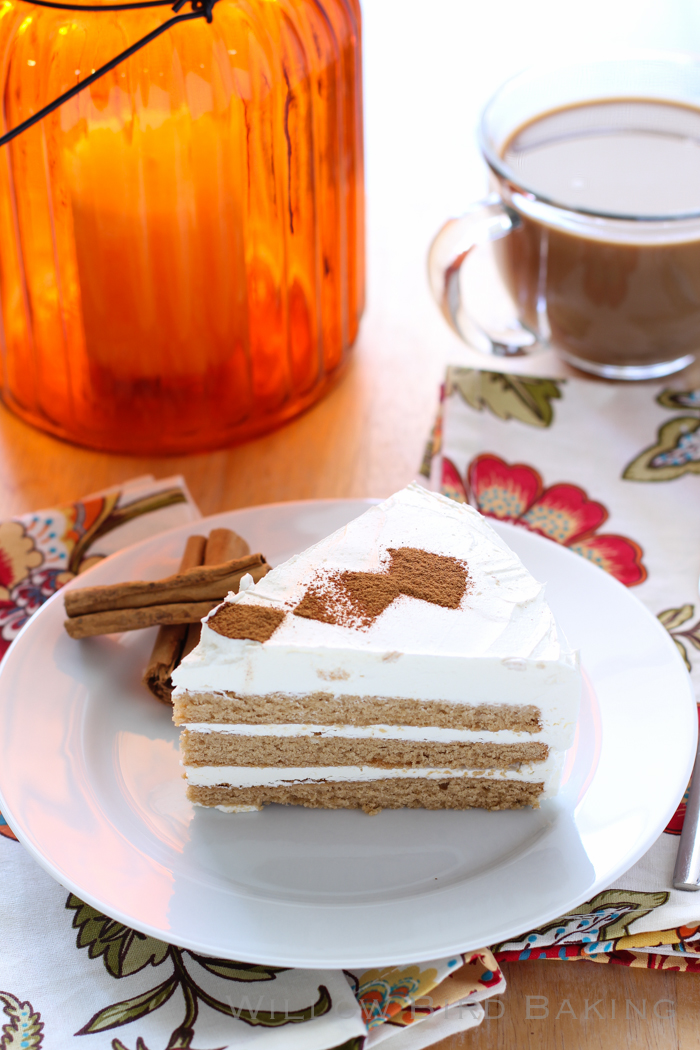
I wrote this post as part of the Plugrá Butter Brigade. Thanks, Plugrá, for sponsoring this post and for making my favorite butter!
Perspective.
In the Middle Ages, art was often used primarily for worship or teaching religious lessons. The portrayal of Biblical figures, therefore, wasn’t meant to be realistic, necessarily, but to point to higher truths. Figures often floated on a backdrop of gold in the absence of a realistic contextual landscape. Their importance dictated their size instead of their position in space (while now, we might paint a person much smaller to show they’re standing far in the distance. You know, if the extent of our artistic talent didn’t abruptly end just past stick figures.)
One of the great innovations of Renaissance painting, often attributed to architect Filippo Brunelleschi (whose incredible dome I saw in Florence, Italy), is realistic linear perspective; that is, illustrating a scene such that it appears to recede in the distance toward an invisible “vanishing point.” Ancient Greeks and Romans knew about linear perspective, but like so much of their knowledge, this method of painting was lost — until the Renaissance, when artists began trying to create realistic paintings. Some Renaissance artists went as far as dissecting corpses, seen as a grave sin in this time, in order to better understand the human form.
The result of this careful study of reality (including, in Brunelleschi’s case, his survey of ancient Roman ruins) was paintings with breathtaking perspective.

Before I learned about the development (or redevelopment) of linear perspective, looking at Renaissance paintings was a lovely but shallow experience for me. They were beautiful, but without knowing that they represented a revolution in thought, I didn’t appreciate them as much as I do now. Learning about the development of linear perspective gave me a broader perspective, if you will, about why the art I was looking at mattered.
I’ve decided this summer is going to be the summer of perspective. In between the pool and lots of visits to Starbucks, I want to spend some time reading, listening, learning, thinking: trying to broaden my understanding of the historical trajectory my life is situated in and my own personal trajectory as a person. What other beliefs do I hold or reject because of my limited perspective? What else am I missing out on because I don’t have context? What struggles am I facing that I could change my perspective on? Maybe these questions are a way to reflect after a hard, wonderful year full of changes: marrying, moving, changing jobs. Over and over again, I’m thankful for my trip to Europe for inspiring me to think about these things.
* * *
 And now, cake. This gorgeous Chai Cake with Swiss Meringue Buttercream is stuffed with spices that complement a gorgeous summer day and smothered with the lightest of light frostings (in terms of texture, that is; don’t count the calories!) Enjoy this sweet indulgence on a balcony or patio for full summer bliss.
And now, cake. This gorgeous Chai Cake with Swiss Meringue Buttercream is stuffed with spices that complement a gorgeous summer day and smothered with the lightest of light frostings (in terms of texture, that is; don’t count the calories!) Enjoy this sweet indulgence on a balcony or patio for full summer bliss.
Have you ever had a life experience that put things into perspective for you?
One year ago: Gooey Chocolate Coconut Cream Skillet Cake
Two years ago: Crispy Baked Sweet Potato Fries with Basil Salt and Lemon Garlic Dipping Sauce
Three years ago: Blueberry Cream Cheese Almond Braid
Four years ago: Santa Fe Breakfast Bake
Chai Cake with Swiss Meringue Buttercream
Recipe by: Adapted from Chef Kevin Kidd of SALT Bistro in Boulder, Colorado
Yield: 12 servings
Swiss meringue buttercream is the lightest, most heavenly frosting on the planet. Now imagine it slathered all over an incredible chai cake. Now imagine eating that cake on the balcony on a summer evening. Now make it happen!
Chai Cake Ingredients:
2/3 cup milk
3 tablespoon loose black chai tea*
1/8 teaspoon ground cardamom, crushed*
sliver of fresh ginger, peeled and grated*
2 whole eggs
1 egg yolk
1 teaspoon vanilla extract
1 cup plus 6 tablespoons flour
1 cup sugar
1 1/4 teaspoon plus 1/8 teaspoon baking powder
1/4 teaspoon plus 1/8 teaspoon cinnamon, ground
1/4 teaspoon kosher salt
1/2 cup (4-ounces) Plugrá® European-Style Butter, unsalted, at room temperature
*If you can only find plain loose black tea, use 1 teaspoon ground cardamom or 7 crushed cardamom pods, 1/2 teaspoon fennel seed, and 1/4-inch of fresh ginger peeled and grated
Swiss Meringue Buttercream Ingredients:
1 1/4 cups sugar
5 egg whites
1 pound Plugrá European-Style Butter, cut into pieces, room temperature
1 teaspoon vanilla extract
Directions:
Make the cake: Preheat the oven to 350 degrees F. Grease and flour the bottom and sides of three 8-inch round cake pans. In a small saucepan over medium-low heat, combine milk, tea, cardamom, fennel, and ginger. Bring it to a simmer but not a boil before removing it from the heat and steeping for 5 minutes. Strain the milk and set it on the counter to cool (I popped mine in the fridge after it had cooled a bit.)
In a medium bowl, whisk together the eggs, egg yolk, vanilla, and 1/3 of the cooled chai milk. In a separate large bowl, whisk together flour, sugar, baking powder, cinnamon, and salt. Beat in softened Plugrá Butter until mixture resembles coarse cornmeal. Add the remaining chai milk and beat on medium-low speed until incorporated. On medium speed, add the egg mixture in three additions, scraping the bowl after each addition. Beat until mixture is light and fluffy. Divide the batter evenly among the pans (it’ll be a pretty thin layer of batter in each pan, so I used a scale to make sure it was accurately divided) and bake for 15-20 minutes, or until a cake tester inserted in the middle comes out with just a few moist crumbs (if you’re using larger pans, like 9-inch pans, they will bake a lot faster, so keep an eye on them!) Cool for 10 minutes before removing the cakes from pans and cooling completely on a wire rack. Then wrap them tight and stick them in the freezer for 30 minutes to make them easier to frost.
Make the frosting: Make sure your butter is softened before you begin — if it’s not totally room temperature, it won’t integrate appropriately. Put egg whites and sugar in the bowl of a stand mixer and place this over a saucepan partially filled with simmering water to create a double-boiler. Whisk the mixture constantly for about 3 minutes or until sugar has completely dissolved. Transfer the mixing bowl to a mixer fitted with a whisk attachment and beat on medium-high speed for 10 minutes, or until the mixture has cooled completely and formed stiff peaks. On medium-high speed, add Plugrá Butter, a tablespoon or so at a time, mixing to incorporate after each addition. If ever your mixture seems to break a bit, whisk on high for a minute or so to re-fluffify it (that’s the technical term, of course) before continuing. After adding all the butter, continue mixing until smooth. Add the vanilla and beat until just combined.
Assemble the cake: Use a daub of frosting to anchor a cake layer on a plate. Spread a little more than 1/2 cup of frosting between each cake layers and let it fall out over the sides of the cake. When your cake is built and even, use this excess frosting to spread a thin crumb coat over the whole cake. Refrigerate for 20 minutes or so for the crumb coat to harden. Then smooth the rest of the frosting over the top and sides of cake in a relatively thick layer to create a pretty finish. Garnish with a sprinkling of cinnamon if desired.
14 Comments on Chai Cake with Swiss Meringue Buttercream
1Pingbacks & Trackbacks on Chai Cake with Swiss Meringue Buttercream
-
[…] I’ll use that gorgeous colored frosting on this chai cake that I would love to […]

Ashley @ Wishes & Dishes
June 16, 2014 at 3:47 pm (11 years ago)I need this cake! It looks amazing!
cheri
June 16, 2014 at 5:00 pm (11 years ago)Hi Julie, very interesting thoughts on perspective, nice that you are dedicating some time to something you feel strongly about. This cake is perfect in many ways, very complex but elegant!
Carolyn
June 17, 2014 at 7:02 am (11 years ago)Oh, I love this cake! Love the chai flavour and I keep meaning to try my hand at buttercream!
Carolyn
June 17, 2014 at 7:03 am (11 years ago)I meant at SWISS buttercream! 😉
Gemma
June 17, 2014 at 11:39 am (11 years ago)Amazing cake! I love how perfect all the layers look and that slice is very very tempting! I could have one right now, hehe.
The chai and all the spices makes it super special and I’m sure it has a nice aroma as well.
🙂
dina
June 17, 2014 at 11:44 am (11 years ago)wonderful flavor!
cate tuten
June 17, 2014 at 12:00 pm (11 years ago)Julie, can not wait to get back home to my kitchen and make this cake. It looks amazing!! Thanks so much for your always lovely posts……Cate
Ace (@toastedsprinkle)
June 17, 2014 at 12:48 pm (11 years ago)So I had almost the exact same experience when I was in undergrad and took the Renaissance painting course. I had a basic knowledge of what made the Renaissance so powerful from my Philosophy courses and general reading of historical fiction but understanding the development (or as you say re-development) of perspective in painting was really drove it home for me. I’m not absolutely fascinated by early/pre-Renaissance painting and constantly compare it to the later works to see just how much they actually differ. It’s such a massive leap and so unexpected it’s almost thrilling.
This cake sounds like the perfect accompaniment to pondering these things too. Can’t wait to try it!
Robin @ thebakingexchange
June 20, 2014 at 12:27 am (11 years ago)Creative and nicely decorated cake. Nice job!
Renee @ Awesome on $20
June 26, 2014 at 1:02 am (11 years ago)This cake sounds beautiful, as does your own personal renaissance. I wish we’d all take a few moments to consider our own perspective before judging others. It might make our lives much more pleasant. Great post!
Julie Ruble
June 26, 2014 at 1:06 am (11 years ago)What a lovely way to put that, Renee: my own personal renaissance. Stealing that 😉 Thanks!
angie
November 6, 2014 at 12:39 am (11 years ago)Julie,
You’re very creative and talented… this cake looks and sounds absolutely delish! I’m thinking of baking it as a light version of a Christmas Cake this year. Do you think adding of a little all-spice would work ?
Also, how many days in advance could I make this cake beforehand?
Will let you know how I go… 🙂
Julie Ruble
November 6, 2014 at 7:00 am (11 years ago)Thanks, Angie! I think you could add a little allspice! You can make the cake layers well ahead of time and double-wrap and freeze them. Then make the frosting and decorate the morning of the day you want to serve it (with plenty of time for it to thaw). Enjoy!